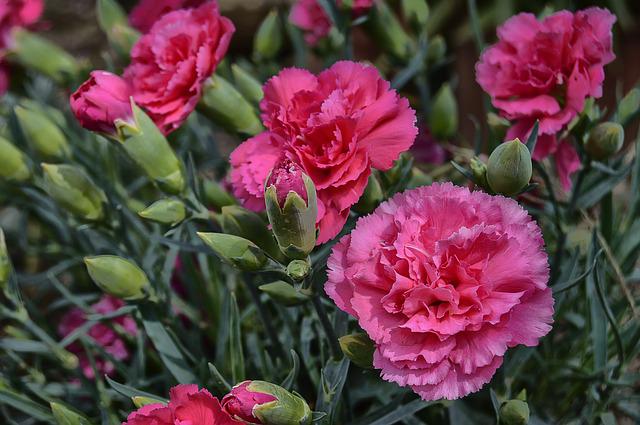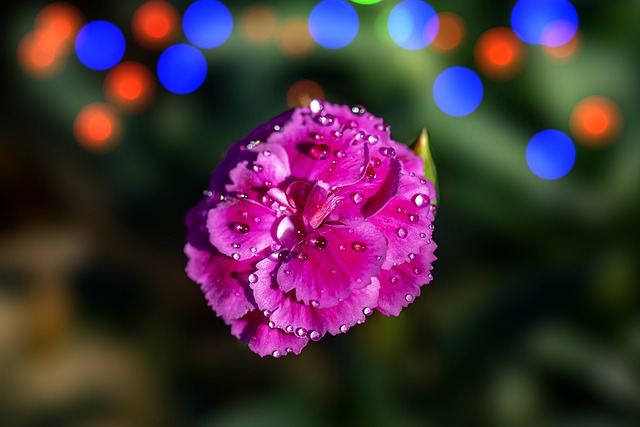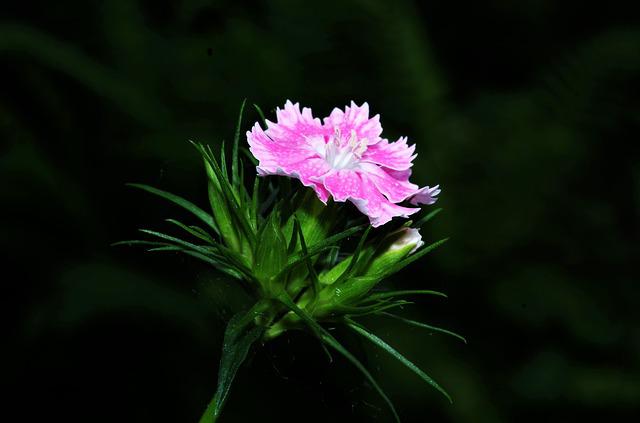Growing Carnation In Pots —Tips for Growing

Carnations are herbaceous perennials grown for their large, showy flowers and ease of care. Each flower on a carnation can be up to 3 inches across.
Most carnations are grown in the ground but can also grow in pots with the right care. Carnations are from Europe and Asia, so they need cool temperatures to grow and do well, but they don’t need much care or maintenance.
- Put some potting soil with good drainage and plenty of nutrients into a container about halfway full. Plant a carnation seed about an eighth of an inch deep in the soil, then give it a little water. Put the potted plant in a spot where it will be exposed to full sunlight for at least four to five hours daily. The germination process should take about six weeks if you keep the soil slightly moist.
- For optimal development of the plant’s flowers and leaves, the temperature should be kept at a constant range of 60-65°F (16-18°C) at all times. A thermometer should be kept in close proximity to the plant at all times to monitor the temperature and ensure that it does not go above 65°F (18°C). Otherwise, the plant could sustain irreversible damage.
- Carnations should be watered once a week to maintain an even moisture level in the soil as they are grown in containers. Be careful not to overwater your carnation, or the leaves will turn yellow and fall off. Avoid moistening the leaves and apply water directly to the soil. Bugs and diseases thrive in wet leaves.
- Carnations should be fertilized with an NPK fertilizer of 20-10-20 every six to eight weeks to supply them with the necessary nutrition. You can find information regarding the correct dosage by reading the instructions printed on the package. Following fertilizer application, give the soil a sprinkling of water to prevent the roots from becoming scorched and ensure that the nutrients reach every part of the soil.
- Harvest blossoms after flowering have begun. After the flowers have faded, prune the carnation plant to be approximately 1 inch above the soil level. This would help the plant overcome the stress of blooming and prepare to bloom again next year.
- Carnations must be repotted every two to three years or whenever their current pot becomes too small, usually in the early spring. This should be done at the latest. Using a new growing medium is recommended, and increasing the container’s depth by three to five inches before replanting a plant.
Table of Contents
Repotting a Carnation Plant
- Choose a spot that gets anywhere from full sun to partial shade.
- Add 2 to 3 inches of compost (or another organic matter) to the top 8 inches of soil to prepare it. Carnations flourish in pH-neutral or slightly alkaline soil with good drainage.
- Prepare a hole that’s large enough to hold the root ball. Put a foot of space between plants to promote healthy air circulation.
- It’s time to plant the carnations, so loosen the potting soil and place it in the holes. The base of a newly transplanted plant should be covered with a loose layer of mulch or organic material. It is best if the soil amendment is not applied directly to the plant.
- Be sure to give the plant a lot of water on the day you plant it. Give the plant at least an inch of water every week, but don’t let it soak the petals or the foliage. Plants’ leaves may become more susceptible to fungal leaf spots if wet.
- Place a stake near the plant’s base as it grows to prevent the stems from breaking. Use a piece of twine or a fabric strip to tie the plant loosely stems to the stake.
- Flowers should be removed from a plant just above a node or stem junction once they have faded. Removing spent blooms can sometimes stimulate new growth.
- Trimmed stems should be no more than 2 inches from the ground after the season has ended.
Developing a Plant from a Cutting
- Using clean, sharp shears, trim a carnation’s thick stem, leaving at least a few leaf nodes. Remember which end of the stem was originally pointing down.
- Remove the leafy tops from the stems.
- Cover the cutting with coarse sand and place it in a container. The stem must be positioned with the same orientation as before, in the sand, the lower end of the stem.
- Wet the sand down completely.
- Drive the stem into the ground a third to half the way.
- Put the container someplace that gets lots of indirect sunlight. The sand needs to be moistened with a water bottle every day.
- About a month after the plant has bloomed, carefully loosen it from the sand with a trowel and remove it. Put it in a pot or on the ground outside.

Growing with Seeds
- Plant seeds into potting soil that drains well, at a depth of about 1/8 inch.
- Separate the seeds by at least 12 inches.
- Press the soil firmly over the seeds and water thoroughly.
- The ideal temperature range for storing growing seeds is between 41-59°F(5-15°C) in a location where it gets full sun
- The seeds need about 2-3 weeks to germinate.
Tips for Growing Carnation in Pots Successfully
Light
Carnations thrive when grown in direct sunlight. Ensure that your plants receive a minimum of six hours of direct sunlight daily for optimal flowering. Carnations will grow in shady locations, but their performance will be diminished.
Planting
Carnations do best when planted in the spring and fall. This gives the roots of the plants time to grow before winter. It’s also important to provide the carnation with plants with enough space between them. The best distance between them is about 6 to 12 inches. Remember that carnations can grow in the same spot for decades. Giving them enough space will keep them from getting too close together. Make sure the plants in pots you buy are healthy when you buy them. If you start with healthy carnation plants, you will have healthy carnations for a long time.
Temperature
Carnations thrive in hardiness zones 3 through 9. The flowers can be grown by gardeners in all of these regions as perennials.
Soil
Carnations thrive in deep, well-draining sandy loam soils. However, they can thrive in various soil types and have no specific soil requirements. Compost or fertilizer must be used to enrich the soil. Ensure that the soil is thoroughly dug, mixed, and loosened.
Watering
You must provide water to freshly planted Carnations. However, avoid keeping the soil wet to prevent root rot. After that, they should be watered only when the soil is dry.
If you are growing them in an area that receives sufficient rainfall, watering them is unnecessary. In relatively arid regions, carnations require weekly or as-needed watering. Avoid having them sit in soggy soils. When leaves are overwatered, they begin to turn yellow.
Mulching
Carnations are required immediately following planting. Mulching helps retain moisture near the plant’s roots, preventing the soil from drying. Mulching also prevents the development of weeds and reduces the competition for water and nutrients that Carnations face.
Fertilizing
Carnations need to be fertilized when they are planted for the first time. Put a compost fertilizer in the hole where the plant will go. These give the plant the nutrients it needs to grow.
After the plants have grown roots, you should only fertilize them when growing. Mix some compost with a small fertilizer and put it around the plant’s base. Add it to the base of the plant.
Deadheading
Carnation deadheading is important because it helps the plant make new blooms. Take off any flowers that are no longer blooming.

Pests and Disease
Carnations are susceptible to pests and diseases. It helps keep them healthy. Regular hand-wiping of the lower parts of the plant with a mild soap solution will help prevent any common foliar problems such as aphids or spider mites.
Propagation
Carnations can be spread most easily by separating the plant’s clumps. The optimal time to divide the plants is when they are planted in the fall.
Use a hand spade to dig up a piece of the plant. Make sure that each part has some roots. Make sure that each piece has more than one eye. Depending on how old the mother plant is, you can get several plants from it.
Plant the pieces immediately, cover them with compost or mulch, and water them. Care to the new carnation plants in the same manner as you would other Carnation plants.
Only split up and used to make more plants should be mature plants. This will make it more likely that both the old and new plants will live.
Some pests might attack carnations. Symptoms include whiteflies, spider mites, aphids, and scale insects. Do not use a lot of pesticides or herbicides on your plants, as it will kill them too. Instead, get rid of the pests with some soap and water.
